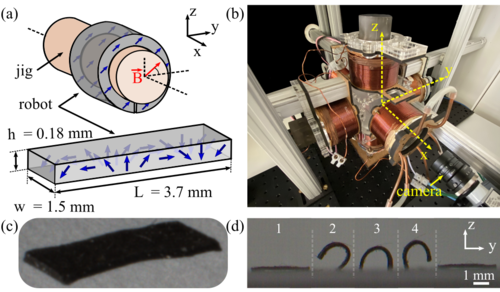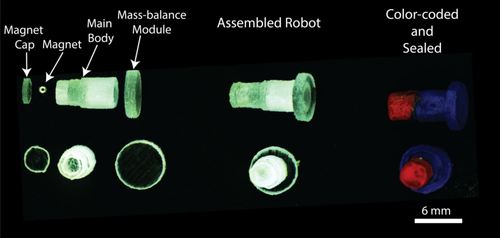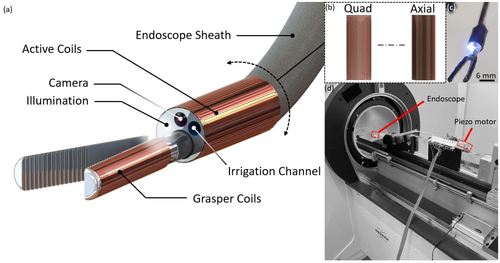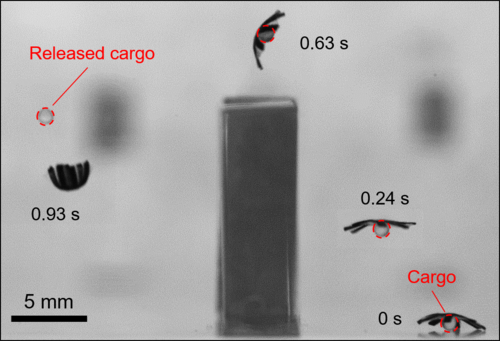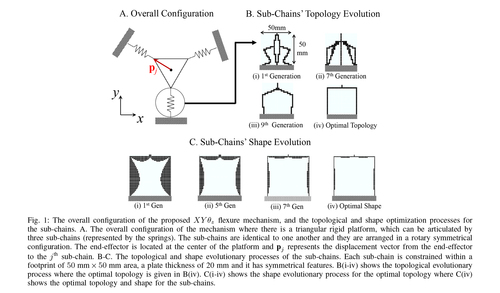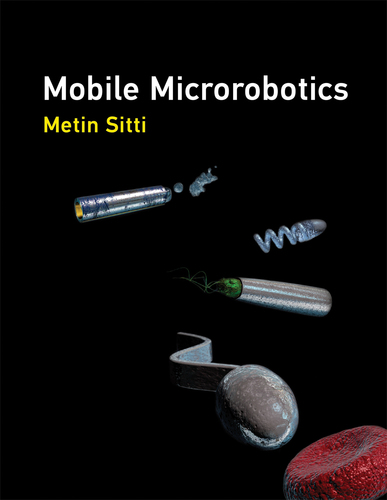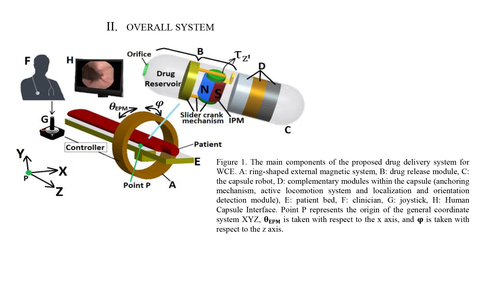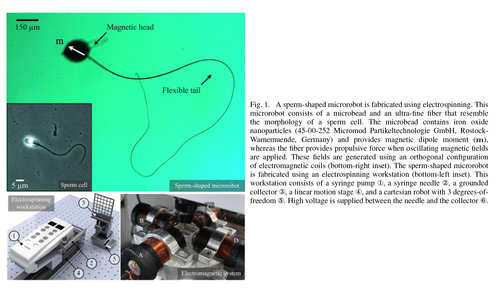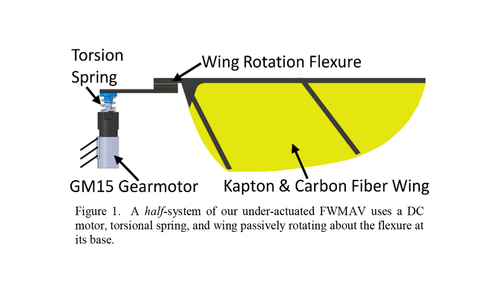2022
Optoacoustic Tracking and Magnetic Manipulation of Cell-Sized Microrobots in Mice
Wrede, P., Degtyaruk, O., Kalva, S. K., Deán-Ben, X. L., Bozuyuk, U., Aghakhani, A., Akolpoglu, B., Sitti, M., Razansky, D.
Clinical and Translational Biophotonics, pages: TTu4B-6, 2022 (conference)
2020
Learning of sub-optimal gait controllers for magnetic walking soft millirobots
Culha, U., Demir, S. O., Trimpe, S., Sitti, M.
In Robotics: Science and Systems XVI, pages: P070, (Editors: Toussaint, Marc and Bicchi, Antonio and Hermans, Tucker), RSS Foundation, Robotics: Science and Systems 2020 (RSS 2020), 2020 (inproceedings)
Towards 5-DoF control of an untethered magnetic millirobot via MRI gradient coils
Design and Development of a Lorentz Force-Based MRI-Driven Neuroendoscope
Phelan III, M. F., Dogan, N. O., Lazovic, J., Sitti, M.
In 2022 IEEE/RSJ International Conference on Intelligent Robots and Systems (IROS), pages: 9534-9541, 2020 (inproceedings)
2019
Collective formation and cooperative function of a magnetic microrobotic swarm
A magnetically-actuated untethered jellyfish-inspired soft milliswimmer
(Best Paper Award)
Robotics: Science and Systems, June 2019 (conference)
Wide range-sensitive, bending-insensitive pressure detection and application to wearable healthcare device
Kim, S., Amjadi, M., Lee, T., Jeong, Y., Kwon, D., Kim, M. S., Kim, K., Kim, T., Oh, Y. S., Park, I.
In 2019 20th International Conference on Solid-State Sensors, Actuators and Microsystems & Eurosensors XXXIII (TRANSDUCERS & EUROSENSORS XXXIII), 2019 (inproceedings)
Printing-while-moving: a new paradigm for large-scale robotic 3D printing
Tiryaki, M. E., Zhang, X., Pham, Q.
2019 IEEE/RSJ International Conference on Intelligent Robots and Systems (IROS 2019), pages: 2286-2291 , IEEE, Piscataway, NJ, IEEE/RSJ International Conference on Intelligent Robots and Systems (IROS 2019), 2019 (conference)
A bio-inspired robotic fish fin with mechanosensation using conductive liquid-metal-infused soft actuators
Liu, Z., Sun, W., Ren, Z., Hu, K., Wang, T., Wen, L.
2019 IEEE 9th Annual International Conference on CYBER Technology in Automation, Control, and Intelligent Systems (CYBER 2019), pages: 689-694, IEEE, Piscataway, NJ, IEEE 9th Annual International Conference on CYBER Technology in Automation, Control, and Intelligent Systems (CYBER 2019) , 2019 (conference)
2018
Enhanced non-steady gliding performance of the MultiMo-Bat through optimal airfoil configuration and control strategy
Collectives of spinning mobile microrobots for navigation and object manipulation at the air-water interface
Wang, W., Kishore, V., Koens, L., Lauga, E., Sitti, M.
In 2018 IEEE/RSJ International Conference on Intelligent Robots and Systems (IROS), pages: 1-9, 2018 (inproceedings)
Endo-VMFuseNet: A deep visual-magnetic sensor fusion approach for endoscopic capsule robots
Turan, M., Almalioglu, Y., Gilbert, H. B., Sari, A. E., Soylu, U., Sitti, M.
In 2018 IEEE International Conference on Robotics and Automation (ICRA), pages: 1-7, 2018 (inproceedings)
Endosensorfusion: particle filtering-based multi-sensory data fusion with switching state-space model for endoscopic capsule robots
Turan, M., Almalioglu, Y., Gilbert, H., Araujo, H., Cemgil, T., Sitti, M.
In 2018 IEEE International Conference on Robotics and Automation (ICRA), pages: 1-8, 2018 (inproceedings)
2017
Swimming in low reynolds numbers using planar and helical flagellar waves
Khalil, I. S. M., Tabak, A. F., Seif, M. A., Klingner, A., Adel, B., Sitti, M.
In 2017 IEEE/RSJ International Conference on Intelligent Robots and Systems (IROS), pages: 1907-1912, International Conference on Intelligent Robots and Systems, September 2017 (inproceedings)
An XY θz flexure mechanism with optimal stiffness properties
Lum, G. Z., Pham, M. T., Teo, T. J., Yang, G., Yeo, S. H., Sitti, M.
In 2017 IEEE International Conference on Advanced Intelligent Mechatronics (AIM), pages: 1103-1110, July 2017 (inproceedings)
Positioning of drug carriers using permanent magnet-based robotic system in three-dimensional space
Khalil, I. S. M., Alfar, A., Tabak, A. F., Klingner, A., Stramigioli, S., Sitti, M.
In 2017 IEEE International Conference on Advanced Intelligent Mechatronics (AIM), pages: 1117-1122, July 2017 (inproceedings)
Self-assembly of micro/nanosystems across scales and interfaces
Dynamic analysis on hexapedal water-running robot with compliant joints
Kim, H., Liu, Y., Jeong, K., Sitti, M., Seo, T.
In 2017 14th International Conference on Ubiquitous Robots and Ambient Intelligence (URAI), pages: 250-251, June 2017 (inproceedings)
Design and actuation of a magnetic millirobot under a constant unidirectional magnetic field
Erin, O., Giltinan, J., Tsai, L., Sitti, M.
In 2017 IEEE International Conference on Robotics and Automation (ICRA), 2017 IEEE International Conference on Robotics and Automation (ICRA), pages: 3404-3410, IEEE, Piscataway, NJ, USA, IEEE International Conference on Robotics and Automation (ICRA), May 2017 (inproceedings)
Magnetically actuated soft capsule endoscope for fine-needle aspiration biopsy
Son, D., Dogan, M. D., Sitti, M.
In Proceedings 2017 IEEE International Conference on Robotics and Automation (ICRA), pages: 1132-1139, IEEE, Piscataway, NJ, USA, 2017 IEEE International Conference on Robotics and Automation (ICRA), May 2017 (inproceedings)
Mobile Microrobotics
Planning spin-walking locomotion for automatic grasping of microobjects by an untethered magnetic microgripper
2016
Steering control of a water-running robot using an active tail
Kim, H., Jeong, K., Sitti, M., Seo, T.
In Intelligent Robots and Systems (IROS), 2016 IEEE/RSJ International Conference on, pages: 4945-4950, October 2016 (inproceedings)
Targeting of cell mockups using sperm-shaped microrobots in vitro
Khalil, I. S., Tabak, A. F., Hosney, A., Klingner, A., Shalaby, M., Abdel-Kader, R. M., Serry, M., Sitti, M.
In 2016 6th IEEE International Conference on Biomedical Robotics and Biomechatronics (BioRob), pages: 495-501, July 2016 (inproceedings)
Analysis of the magnetic torque on a tilted permanent magnet for drug delivery in capsule robots
Munoz, F., Alici, G., Zhou, H., Li, W., Sitti, M.
In 2016 IEEE International Conference on Advanced Intelligent Mechatronics (AIM), pages: 1386-1391, July 2016 (inproceedings)
Sperm-shaped magnetic microrobots: Fabrication using electrospinning, modeling, and characterization
Khalil, I. S., Tabak, A. F., Hosney, A., Mohamed, A., Klingner, A., Ghoneima, M., Sitti, M.
In 2016 IEEE International Conference on Robotics and Automation (ICRA), pages: 1939-1944, May 2016 (inproceedings)
2015
Compliant wing design for a flapping wing micro air vehicle
Colmenares, D., Kania, R., Zhang, W., Sitti, M.
In Intelligent Robots and Systems (IROS), 2015 IEEE/RSJ International Conference on, pages: 32-39, September 2015 (inproceedings)
Millimeter-scale magnetic swimmers using elastomeric undulations
Zhang, J., Diller, E.
In 2015 IEEE/RSJ International Conference on Intelligent Robots and Systems (IROS), 2015 IEEE/RSJ International Conference on Intelligent Robots and Systems (IROS), pages: 1706-1711, September 2015 (inproceedings)
Fiberbot: A miniature crawling robot using a directional fibrillar pad
Han, Y., Marvi, H., Sitti, M.
In Robotics and Automation (ICRA), 2015 IEEE International Conference on, pages: 3122-3127, May 2015 (inproceedings)
Platform design and tethered flight of a motor-driven flapping-wing system
Hines, L., Colmenares, D., Sitti, M.
In Robotics and Automation (ICRA), 2015 IEEE International Conference on, pages: 5838-5845, May 2015 (inproceedings)
2014
Geckogripper: A soft, inflatable robotic gripper using gecko-inspired elastomer micro-fiber adhesives
Song, S., Majidi, C., Sitti, M.
In Intelligent Robots and Systems (IROS 2014), 2014 IEEE/RSJ International Conference on, pages: 4624-4629, September 2014 (inproceedings)
Three-dimensional robotic manipulation and transport of micro-scale objects by a magnetically driven capillary micro-gripper
Giltinan, J., Diller, E., Mayda, C., Sitti, M.
In Robotics and Automation (ICRA), 2014 IEEE International Conference on, pages: 2077-2082, 2014 (inproceedings)
Robotic assembly of hydrogels for tissue engineering and regenerative medicine
Tasoglu, S, Diller, E, Guven, S, Sitti, M, Demirci, U
In Journal of Tissue Engineering and Regenerative Medicine, 8, pages: 181-182, 2014 (inproceedings)
Versatile non-contact micro-manipulation method using rotational flows locally induced by magnetic microrobots
Ye, Z., Edington, C., Russell, A. J., Sitti, M.
In Advanced Intelligent Mechatronics (AIM), 2014 IEEE/ASME International Conference on, pages: 26-31, 2014 (inproceedings)
Structural optimization method towards synthesis of small scale flexure-based mobile grippers
Lum, G. Z., Diller, E., Sitti, M.
In Robotics and Automation (ICRA), 2014 IEEE International Conference on, pages: 2339-2344, 2014 (inproceedings)
Six-Degrees-of-Freedom Remote Actuation of Magnetic Microrobots.
Diller, E. D., Giltinan, J., Lum, G. Z., Ye, Z., Sitti, M.
In Robotics: Science and Systems, 2014 (inproceedings)
2013
Angular Motion Control Using a Closed-Loop CPG for a Water-Running Robot
Thatte, N., Khoramshahi, M., Ijspeert, A., Sitti, M.
In Dynamic Walking 2013, (EPFL-CONF-199763), 2013 (inproceedings)
A hybrid topological and structural optimization method to design a 3-DOF planar motion compliant mechanism
Lum, G. Z., Teo, T. J., Yang, G., Yeo, S. H., Sitti, M.
In Advanced Intelligent Mechatronics (AIM), 2013 IEEE/ASME International Conference on, pages: 247-254, 2013 (inproceedings)
Light-induced microbubble poration of localized cells
Fan, Qihui, Hu, Wenqi, Ohta, Aaron T
In Engineering in Medicine and Biology Society (EMBC), 2013 35th Annual International Conference of the IEEE, pages: 4482-4485, 2013 (inproceedings)
SoftCubes: towards a soft modular matter
Yim, S., Sitti, M.
In Robotics and Automation (ICRA), 2013 IEEE International Conference on, pages: 530-536, 2013 (inproceedings)
Three dimensional independent control of multiple magnetic microrobots
Diller, E., Giltinan, J., Jena, P., Sitti, M.
In Robotics and Automation (ICRA), 2013 IEEE International Conference on, pages: 2576-2581, 2013 (inproceedings)
A Perching Mechanism for Flying Robots Using a Fibre-Based Adhesive
Daler, L., Klaptocz, A., Briod, A., Sitti, M., Floreano, D.
In Robotics and Automation (ICRA), 2013 IEEE International Conference on, 2013 (inproceedings)
Bonding methods for modular micro-robotic assemblies
Diller, E., Zhang, N., Sitti, M.
In Robotics and Automation (ICRA), 2013 IEEE International Conference on, pages: 2588-2593, 2013 (inproceedings)
2012
Topological optimization for continuum compliant mechanisms via morphological evolution of traditional mechanisms
Lum, GZ, Yeo, SH, Yang, GL, Teo, TJ, Sitti, M
In 4th International Conference on Computational Methods, pages: 8, 2012 (inproceedings)
Flapping Wings with DC-Motors via Direct, Elastic Transmissions
Azhar, M., Campolo, D., Lau, G., Sitti, M.
In Proceedings of International Conference on Intelligent Unmanned Systems, 8, 2012 (inproceedings)
Investigation of bioinspired gecko fibers to improve adhesion of HeartLander surgical robot
Tortora, G., Glass, P., Wood, N., Aksak, B., Menciassi, A., Sitti, M., Riviere, C.
In Engineering in Medicine and Biology Society (EMBC), 2012 Annual International Conference of the IEEE, pages: 908-911, 2012 (inproceedings)
Magnetic hysteresis for multi-state addressable magnetic microrobotic control
Diller, E., Miyashita, S., Sitti, M.
In Intelligent Robots and Systems (IROS), 2012 IEEE/RSJ International Conference on, pages: 2325-2331, 2012 (inproceedings)
2011
Design and analysis of a magnetically actuated and compliant capsule endoscopic robot
Yim, S., Sitti, M.
In Robotics and Automation (ICRA), 2011 IEEE International Conference on, pages: 4810-4815, 2011 (inproceedings)



